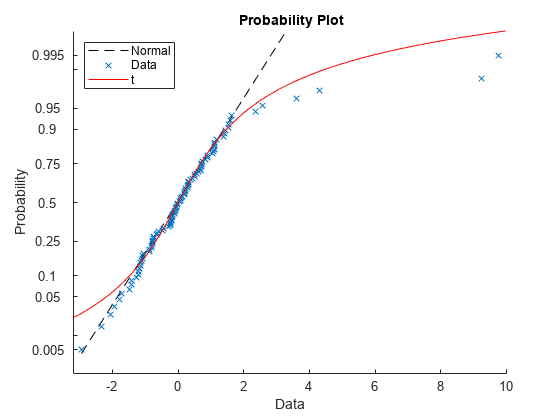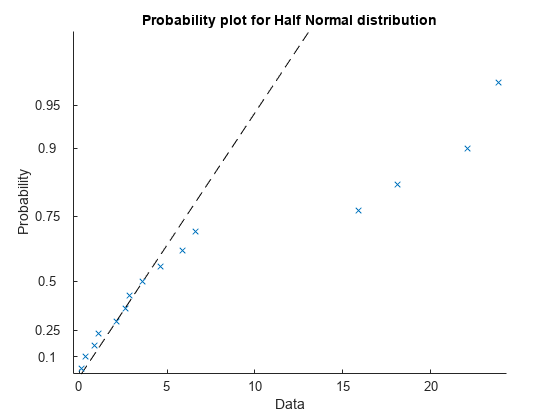probplot
確率プロット
構文
説明
probplot( は、y)y 内のデータの分布を正規分布と比較する正規確率プロットを作成します。
probplot は、マーカー記号を使用して y 内の各データ点をプロットし、理論的な分布を表す基準線を描画します。標本データが正規分布に従っている場合、データ点は基準線に沿って現れます。基準線は、データの 1 番目と 3 番目の四分位数を結んで、データの端まで伸びます。正規分布ではない場合、データ プロットが曲がります。
probplot( は、前の構文のいずれかの入力引数を使用して、ax,___)ax で指定された既存の確率プロットの座標軸に確率プロットを追加します。
probplot(___,'noref') は、プロットの基準線を省略します。
例
入力引数
出力引数
アルゴリズム
probplot は、与えられた確率分布の分位数に標本データの分位数を一致させます。標本データは並べ替えられ、dist の選択に従ってスケーリングされ、x 軸に対してプロットされます。dist が 'lognormal'、'loglogistic' または 'weibull' である場合、スケーリングは対数になります。それ以外では、スケーリングは線形です。y 軸は、dist で指定された分布の分位数を、確率値に変換して表します。スケーリングは与えられた分布によって異なり、線形ではありません。
サイズが N の標本を並べ替えた i 番目の値が x 軸の値である場合、y 軸の値はデータの経験累積分布関数に対する評価点間の中点です。データが打ち切られていない場合、中点は に等しくなります。
probplot は、プロットの線形性を評価するため、基準線を重ね合わせます。データが打ち切られていない場合、この線はデータの 1 番目と 3 番目の四分位数を通過します。データが打ち切られている場合、それに従って線が移動します。データが打ち切られておらず、dist が 'half normal' である場合、probplot は 0 番目と 2 番目の四分位数を代わりに使用します。
バージョン履歴
R2006a より前に導入




